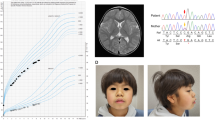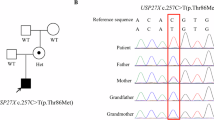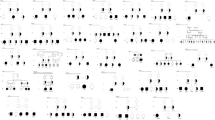Abstract
X-linked intellectual disability (XLID), also known as X-linked mental retardation, is a highly genetically heterogeneous condition for which mutations in >90 different genes have been identified. In this study, we used a custom-made sequencing array based on the Affymetrix 50k platform for mutation screening in 17 known XLID genes in patients from 135 families and found eight single-nucleotide changes that were absent in controls. For four mutations affecting ATRX (p.1761M>T), PQBP1 (p.155R>X) and SLC6A8 (p.390P>L and p.477S>L), we provide evidence for a functional involvement of these changes in the aetiology of intellectual disability.
Similar content being viewed by others
Log in or create a free account to read this content
Gain free access to this article, as well as selected content from this journal and more on nature.com
or
References
Ropers HH : Genetics of intellectual disability. Curr Opin Genet Dev 2008; 18: 241–250.
Leonard H, Wen X : The epidemiology of mental retardation: challenges and opportunities in the new millennium. Ment Retard Dev Disabil Res Rev 2002; 8: 117–134.
Gécz J, Shoubridge C, Corbett M : The genetic landscape of intellectual disability arising from chromosome X. Trends Genet 2009; 25: 308–316.
Schroeder C, Stutzmann F, Weber BH, Riess O, Bonin M : High-throughput resequencing in the diagnosis of BRCA 1/2 mutations using oligonucleotide resequencing microarrays. Breast Cancer Res Treat 2010; 122: 287–297.
Longo I, Frints SG, Fryns JP et al: A third MRX family (MRX68) is the result of mutation in the long chain fatty acid-CoA ligase 4 (FACL4) gene: proposal of a rapid enzymatic assay for screening mentally retarded patients. J Med Genet 2003; 40: 11–17.
Almeida LS, Verhoeven NM, Roos B et al: Creatine and guanidinoacetate: diagnostic markers for inborn errors in creatine biosynthesis and transport. Mol Genet Metab 2004; 82: 214–219.
Musante L, Kunde SA, Sulistio TO et al: Common pathological mutations in PQBP1 induce nonsense-mediated mRNA decay and enhance exclusion of the mutant exon. Hum Mutat 2010; 31: 90–98.
Hartmann A, Thieme M, Nanduri LK et al: Validation of microarray-based resequencing of 93 worldwide mitochondrial genomes. Hum Mutat 2009; 30: 115–122.
Fokstuen S, Lyle R, Munoz A et al: A DNA resequencing array for pathogenic mutation detection in hypertrophic cardiomyopathy. Hum Mutat 2008; 29: 879–885.
Rosenberg EH, Almeida LS, Kleefstra T et al: High prevalence of SLC6A8 deficiency in X-linked mental retardation. Am J Hum Genet 2004; 75: 97–105.
Rosenberg EH, Martínez Muñoz C, Betsalel OT et al: Functional characterization of missense variants in the creatine transporter gene (SLC6A8): improved diagnostic application. Hum Mutat 2007; 28: 890–896.
Kalscheuer VM, Freude K, Musante L et al: Mutations in the polyglutamine binding protein 1 gene cause X-linked mental retardation. Nat Genet 2003; 35: 313–315.
de Brouwer AP, Yntema HG, Kleefstra T et al: Mutation frequencies of X-linked mental retardation genes in families from the EuroMRX consortium. Hum Mutat 2007; 28: 207–208.
Tarpey PS, Smith R, Pleasance E et al: A systematic, large-scale resequencing screen of X-chromosome coding exons in mental retardation. Nat Genet 2009; 41: 535–543.
Kothiyal P, Cox S, Ebert J, Aronow BJ, Greinwald JH, Rehm HL : An overview of custom array sequencing. Curr Protoc Hum Genet 2009 Chapter 7:Unit 7.17.
Hodges E, Rooks M, Xuan Z et al: Hybrid selection of discrete genomic intervals on custom-designed microarrays for massively parallel sequencing. Nat Protoc 2009; 4: 960–974.
Acknowledgements
We thank Sven Poths for technical assistance. This study was supported by the Max Planck Innovation Fund. Additional funding was provided to HHR by the German Federal Ministry of Education and Research (MRNET 01GS08161-2).
Author information
Authors and Affiliations
Corresponding author
Ethics declarations
Competing interests
The authors declare no conflict of interest.
Additional information
Databases
UCSC Genome Browser: http://genome.ucsc.edu/cgi-bin/hgTracks?org=human
The Human Gene Mutation Database: http://www.hgmd.cf.ac.uk/ac/validate.php
Ensembl: http://www.ensembl.org/index.html
Euro-MRX Consortium: http://www.euromrx.com
Supplementary Information accompanies the paper on European Journal of Human Genetics website
Supplementary information
Rights and permissions
About this article
Cite this article
Jensen, L., Chen, W., Moser, B. et al. Hybridisation-based resequencing of 17 X-linked intellectual disability genes in 135 patients reveals novel mutations in ATRX, SLC6A8 and PQBP1. Eur J Hum Genet 19, 717–720 (2011). https://doi.org/10.1038/ejhg.2010.244
Received:
Revised:
Accepted:
Published:
Issue date:
DOI: https://doi.org/10.1038/ejhg.2010.244
Keywords
This article is cited by
-
Molecular consequences of PQBP1 deficiency, involved in the X-linked Renpenning syndrome
Molecular Psychiatry (2024)
-
Brief Report: Evidence of Autism Spectrum Disorder Caused by a Mutation in ATRX Gene: A Case Report
Journal of Autism and Developmental Disorders (2024)
-
Mapping the landscape of tandem repeat variability by targeted long read single molecule sequencing in familial X-linked intellectual disability
BMC Medical Genomics (2018)
-
Changes in the folding landscape of the WW domain provide a molecular mechanism for an inherited genetic syndrome
Scientific Reports (2016)
-
Downregulation of the Creatine Transporter SLC6A8 by JAK2
The Journal of Membrane Biology (2012)



